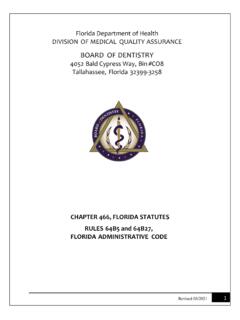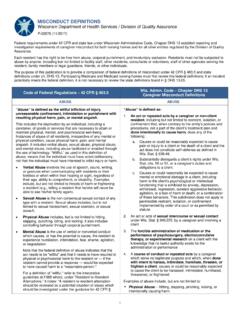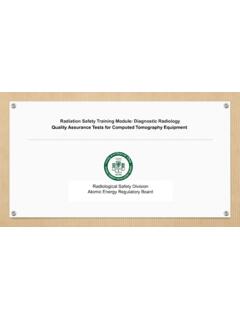Transcription of Quality Assurance in Tertiary Education: Current Practices ...
1 Quality Assurance in Tertiary Education: Current Practices in OECD Countries and a Literature Review on Potential Effects Viktoria Kis*. August 2005. * This paper is a contribution to the OECD Thematic Review of Tertiary Education ( ). It was prepared by Viktoria Kis, a graduate student at the Institut d'Etudes Politiques de Paris (Sciences Po), France, during an internship at the Education and Training Policy Division, Directorate for Education, OECD for the period July-August 2005. The opinions expressed in this paper are the sole responsibility of the author and do not necessarily reflect those of the OECD or the governments of its Member countries. TABLE OF CONTENTS. 1 INTRODUCTION .. 3. 2 TYPOLOGY AND DESCRIPTION OF EXISTING NATIONAL Quality Assurance SYSTEMS IN HIGHER. EDUCATION .. 3. Definitions for Quality in higher 3.
2 Approaches to Quality Assurance .. 5. Level of Quality 6. Scope of evaluation .. 6. Key agencies and organisations involved in Quality Assurance .. 6. Criteria and standards .. 7. Methods used for Quality review .. 8. Data gathering 8. Nature and purpose of Quality 10. Outcomes of Quality Assurance mechanisms .. 11. The cost of evaluation .. 12. 3 ADVANTAGES AND DISADVANTAGES OF DIFFERENT Quality Assurance MECHANISMS IN. Tertiary EDUCATION .. 12. Purpose of Quality Assurance : accountability vs. 12. Adequate methods and 14. External vs. internal 14. Institutional vs. programme 17. Data gathering instruments .. 18. Relationship between evaluation of education and of 20. Consequences: links with funding? .. 21. 4 DIFFICULTIES IN IMPLEMENTING EFFECTIVE Quality Assurance SYSTEMS .. 23. Different interests and conceptions of Quality between diverse stakeholders.
3 23. The implementation gap' .. 24. External ownership leading to compliance instead of 25. 5 EMPIRICAL EVIDENCE ON THE EFFECTS OF Quality Assurance MECHANISMS ON Tertiary . EDUCATION 26. The impact of Quality Assurance systems .. 26. Difficulties in measuring the impact of Quality Assurance .. 26. Impact on teaching and learning .. 27. Impact on organisation and management issues within 28. Academics perception of and behaviour in response to Quality Assurance .. 29. Some features of effective Quality Assurance 30. 6 CONCLUSION .. 33. LIST OF ACRONYMS .. 34. REFERENCES .. 35. ANNEX 1: MAJOR ELEMENTS OF Quality Assurance SYSTEMS IN Tertiary EDUCATION .. 41. ANNEX 2: AN OVERVIEW OF Quality Assurance SYSTEMS IN PRACTICE IN SELECTED COUNTRIES . 42. 2. 1 Introduction 1. This paper examines the Current academic and policy literatures surrounding Quality Assurance in Tertiary education.
4 It provides a typology of existing national Quality Assurance mechanisms, in addition to presenting the advantages and disadvantages of different Quality Assurance systems. Finally, it provides an account of the Current empirical evidence on the effects of Quality Assurance mechanisms. 2. One limitation of this paper should be noted: it focuses principally on Quality Assurance systems that assess Quality of teaching and learning as opposed to the Quality of research. A major reason for this is that literature on Quality Assurance processes concentrates more on Quality issues related to teaching and learning than on research. Vroeijenstijn (1995a), for instance, argues that focusing on Quality of teaching and learning may be justified by the fact that it raises more questions than does Quality of research. In the case of research there are already well-established Quality assessment mechanisms based on peer-reviews.
5 Publications in refereed journals can be assessed, conferences allow researchers to discuss each other's work and research funding allocation is often based on the Quality of proposals. Such an open scholarly community that would allow the evaluation of each other's activities does not exist in the case of teaching and learning. 3. On the other hand the development of Quality Assurance of teaching and learning is more recent. Several broad trends have fostered interest in Quality Assurance policies in higher education; including the trend toward mass higher education, growing diversity of educational offerings, the internationalisation of higher education and the expansion of private higher education institutions and of distance learning (El- Khawas et al., 1998). In numerous countries, a further factor has been the growing pressure on governments to limit public expenditure.
6 Furthermore, guiding student demand to fields that are important for economic development is a key issue in the transition to technology-based economies (Van Vught and Westerheijden, 1994). 4. This paper has four sections. Section two examines different types of existing national Quality Assurance systems in higher education. Section three presents the advantages and disadvantages of different approaches to Quality Assurance . Section four considers difficulties in implementing effective Quality Assurance systems. Finally, section five summarises Current evidence on the effects of Quality Assurance systems. 2 Typology and description of existing national Quality Assurance systems in higher education 5. This section summarises the key features of existing national systems of Quality Assurance in Tertiary education within the OECD area.
7 Definitions for Quality in higher education 6. The term Quality Assurance refers to systematic, structured and continuous attention to Quality in terms of Quality maintenance and improvement (Vroeijenstijn, 1995a). As cited in Watty (2003), a further review of the literature around change in higher education reveals two schools of thought: The first attaches Quality to a context and as a consequence Quality becomes meaningful (Baird, 1988; Fry, 1995; Nordvall and Braxton, 1996). For example, references to the 3. Quality of assessment, student intake, academic programmes, teaching and learning, the student experience and programme designs are not uncommon. Any attempt to define or attach meaning to the term is largely ignored and one is left to assume that it is high'. Quality that is being referred to as opposed to good' or poor' Quality .
8 A second way of thinking about Quality relates to a stakeholder-specific meaning. Here Quality is considered, having regard to a variety of stakeholders with an interest in higher education, each having the potential to think about Quality in different ways. In particular, the early works of Vroeijenstijn (1992), Middlehurst (1992) and Harvey and Green (1993). highlight the importance and value of considering Quality from a variety of stakeholder perspectives. 7. Harvey and Green (1993) identify five categories or ways of thinking about Quality . As cited in Watty (2003) key aspects of each of these categories can be summarised as follows: Exception: distinctive, embodies in excellence, passing a minimum set of standards. Perfection: zero defects, getting things right the first time (focus on process as opposed to inputs and outputs).
9 Fitness for purpose: relates Quality to a purpose, defined by the provider. Value for money: a focus on efficiency and effectiveness, measuring outputs against inputs. A. populist notion of Quality (government). Transformation: a qualitative change; education is about doing something to the student as opposed to something for the consumer. Includes concepts of enhancing and empowering: democratisation of the process, not just outcomes. Watty (2003) suggests that the dimension of Quality as perfection can be removed, since higher education does not aim to produce defect-free graduates. Lomas (2001) suggests that fitness for purpose and transformation seem to be the two most appropriate definitions of Quality , according to small-scale research with a sample of senior managers in higher education institutions.
10 Figure 1. Definitions for Quality Quality Exceptional Perfection, Fitness for Value for Transformation Consistency purpose money Distinctive learner Zero Defects Customer specified mission Efficient/effective Enhancing and Excellence Provider specified mission empowering the student High Standards learner Excellence . Minimum standards learner Source: Watty, 2003 p. 215. 4. Approaches to Quality Assurance 8. This section describes the different approaches to Quality that can be taken by Quality Assurance systems. Quality Assurance agencies can adopt one or more of these according to different educational systems and traditions (Woodhouse, 1999). 9. The three main approaches to Quality are accreditation, assessment and audit. Accreditation and evaluation (which includes assessment and audit) differ in their perspectives.















